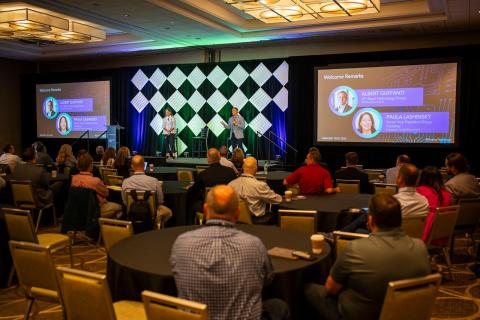Grocery’s Biggest Opportunity

OPINION: EDITOR'S NOTE
Progressive Grocer just had its first annual GroceryTech conference in Cincinnati, Ohio, in July, and one thing is certain: Nothing is certain in the grocery industry anymore, not even Christmas.
But technology can help.
At PG’s GroceryTech event, one food retailer based in the Northeast talked about how an unprecedented amount of snowfall led to store closures in the weeks before Christmas. Cities were shut down and residents were told to stay in their homes. When the streets were safe again, the grocer was able to leverage technology to deploy employees to deliver groceries to hundreds of customers stuck in their homes without a way to obtain fresh food.
That was just one of many captivating stories from GroceryTech, which featured a theme of Scaling With Personalization. Progressive Grocer and sister brand RIS News hosted the event featuring timely sessions on personalization, technology transformation, customer experience, artificial intelligence, automation, and more. Speakers hailed from companies such as Kroger, Google, Giant Eagle, Mercatus, The Fresh Market, Inmar Intelligence, Wakefern Food Corp., Preferabli and many more.
The conference was the capstone to a summer focused on grocery technology here at Progressive Grocer. We also co-sponsored with RIS News the 8th annual Grocery Tech TrendsStudy, which surveyed both grocery executives and consumers and was brilliantly summarized by PG contributing editor Jenny McTaggart.
The survey showed that retailers are making solid investments for the future and prioritizing the right customer-facing tech. Consumers meanwhile said they’re eager to try new technology that can save money and make their shopping experiences better; yet like retailers, they don’t want tech to overtake the human connection that they’ve come to appreciate in the in-store environment. At the same time, more shoppers — especially younger generations — are increasingly relying on the convenience of online ordering and delivery.
More than half of retailers surveyed (57%) say they expect their tech spending to increase in the next 12 to 18 months. They recognize that they’ll have to make tradeoffs between upgrades and new tech, and for now they’re split on whether to concentrate on customer-facing tech (46%) or back-end tech (39%).
When it comes to the back end, grocers anticipate spending more on store operations, namely in the areas of data analytics and people management. This year’s study found that e-commerce is expected to be one of the greatest growth drivers over the next year and a half. Looking ahead, 65% expect that delivery will drive the most growth, and 50% are betting on ultra-fast delivery in 30 minutes or less.

Meanwhile consumers told us that nearly four in 10 now shop online for delivery monthly, and around 50% of Generation Z and Millennials shop online using either delivery, curbside pickup or in-store pickup monthly. Interestingly, only 5% of shoppers surveyed currently feel ready to try ultra-fast delivery, but that could very well change as the service becomes more prevalent. The consumer survey unmasked some of the top barriers to online grocery shopping, led by “prefer to pick products myself, in person” (72%), followed by “don’t trust the quality of products selected” (43%).
Technology is also playing a significant role often before the shopping trip even begins. Almost three-fourths of grocery shoppers (72%) say they use digital coupons regularly or occasionally, while 67% use loyalty programs. Just over half use digital sales flyers (59%) or cash-back reward programs (53%) such as Ibotta and Shopkick.
For those who missed the Grocery Tech Trends Study or GroceryTech event and want a review of some of the buzziest ideas in the industry right now, click on the QR code above to get more information. We are already in the planning stages for next year’s event and study, and we welcome your ideas about transformational technology in grocery.







